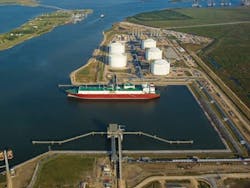New LNG projects strengthen U.S. position as world's largest Exporter
Even as Russia decreases its flow of natural gas into Europe, the United States strengthens its claim as the world’s top liquified natural gas (LNG) exporter after only six years of export activity.
A new report by the federal Energy Information Administration says that addition of three new major LNG terminal projects on the Gulf Coast should bring total U.S. LNG export capacity to nearly 17 billion cubic feet per day (bcf/d) over the next few years. Much of this product at these export facilities, which chill U.S. natural gas to liquify and make it stable for shipping, will go to customers in Europe, Asia and Africa.
The projects under construction are the Golden Pass, Plaquemines and Corpus Christi Stage III terminals. Altogether, they would add 5.7 bcf/d by 2025, according to the EIA.
Subscribe to our free newsletter for more Insights into the C&I Energy Transition
Each terminal site utilitizes refrigeration trains to chill the natural gas to temperatures to minus 260 degree Fahrenheit (162 Celsisus). This converts the gas into a liquid, which is then exported to regasification units in other nations and then used for heating and power generation.
The dramatic rise in LNG export capacity was made possible by the shale gas drilling revolution combining hydraulic fracturing and directional drilling. U.S. production broke yet another record last year by topping 90 billion cubic feet per day, according to reports.
Other LNG export terminals now completed and in operation include Sabine Pass, Corpus Christi, Cameron, Freeport, and Calcasieu Pass. The latter is the most recent completed.
About the Author
Rod Walton, EnergyTech Managing Editor
Managing Editor
For EnergyTech editorial inquiries, please contact Managing Editor Rod Walton at [email protected].
Rod Walton has spent 17 years covering the energy industry as a newspaper and trade journalist. He formerly was energy writer and business editor at the Tulsa World. Later, he spent six years covering the electricity power sector for Pennwell and Clarion Events. He joined Endeavor and EnergyTech in November 2021.
Walton earned his Bachelors degree in journalism from the University of Oklahoma. His career stops include the Moore American, Bartlesville Examiner-Enterprise, Wagoner Tribune and Tulsa World.
EnergyTech is focused on the mission critical and large-scale energy users and their sustainability and resiliency goals. These include the commercial and industrial sectors, as well as the military, universities, data centers and microgrids. The C&I sectors together account for close to 30 percent of greenhouse gas emissions in the U.S.
He was named Managing Editor for Microgrid Knowledge and EnergyTech starting July 1, 2023
Many large-scale energy users such as Fortune 500 companies, and mission-critical users such as military bases, universities, healthcare facilities, public safety and data centers, shifting their energy priorities to reach net-zero carbon goals within the coming decades. These include plans for renewable energy power purchase agreements, but also on-site resiliency projects such as microgrids, combined heat and power, rooftop solar, energy storage, digitalization and building efficiency upgrades.

